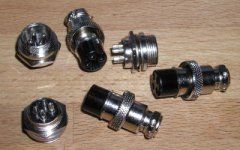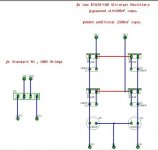Those are really nice connectors I buy at local store. I need 4 pins (2 rails, 2 grounds) and I didn't even look for suitable Neutrik connectors. The ones I'm using are smaller, they seem more robust than XLR, non magnetic and they don't look like signal connectors. And what's most important, they sound really well.😉
I don't know what these connectors are called, but they were often used for microphone connections on CB radios.
thanks 🙂 for that picture steve - i've been looking for it for a long time to help me make a point or two!
mlloyd1
mlloyd1
Steve Eddy said:...Our mind....The objective reality is ...
se
Here's the pic of those connectors. I was looking through pages of Digi-Key catalog and couldn't find anything suitable. Those I found in my local store. Unfortunately they had limited stock and I bought them all. They expect to restock in 2 months. Anybody knows another source for them?
Attachments
Peter Daniel said:Here's the pic of those connectors. I was looking through pages of Digi-Key catalog and couldn't find anything suitable. Those I found in my local store. Unfortunately they had limited stock and I bought them all. They expect to restock in 2 months. Anybody knows another source for them?
Those are your basic CB microphone connectors. I believe Radio Shack still carries them.
se
Asen said:Peter,
Is the PSU-to-amp cable shielded? If so, how is the shield grounded? And where?
Thanks
The first PS didn't have shielded cable. Just 8 runs of silver plated, stranded copper wire in teflon jacket. On later amps I used 4TC kable speaker wire (it is somewhat self shielded). But it seems that the first supply sounded better, it's hard to believe that wire makes a difference, but I still have to investigate it.
I run one extra wire from mains earth plug to amp's chassis, later I grounded the amp chassiss from speaker output ground. In both cases it worked fine and didn't cause interference. The amp chassiss had to be grounded, otherwise minimized gainclone tends to oscilate.
Thanks for info on those CB connectors.
😉
Gainclone PSU
Seems like this is almost the official GC thread, so I just post this here:
After using my GC , from Peter's circiut, I did the following to the PSU and found that it was a deffinate improvement. The sound became more transparent and gained in clarity .
The origenal circiut is from Maarten:
http://www.euronet.nl/~mgw/diy/amps/uk_geenkloon_2.html
I replaced option A: with B:
Seems like this is almost the official GC thread, so I just post this here:
After using my GC , from Peter's circiut, I did the following to the PSU and found that it was a deffinate improvement. The sound became more transparent and gained in clarity .
The origenal circiut is from Maarten:
http://www.euronet.nl/~mgw/diy/amps/uk_geenkloon_2.html
I replaced option A: with B:
Attachments
Peter,
What do you use in your system - a Pass designed amp or a Gainclone?
I'm asking that question because some time has passed and I know that it always takes time for a precise evaluation to be made. At least in audio...
Regards
PS - Sory, but even after ordering 4 LM chips I'm still sceptical
What do you use in your system - a Pass designed amp or a Gainclone?
I'm asking that question because some time has passed and I know that it always takes time for a precise evaluation to be made. At least in audio...
Regards
PS - Sory, but even after ordering 4 LM chips I'm still sceptical
In my main system I'm using Aleph X. In my basement system the Gainclone replaced the original Zen amp. I did not do side by side tests: Gainclone/Aleph, but I have a feeling that they are comparable.
And if you play loud with your gainclone, does it still sound good ? Not harsh and well controlled ?
I don't really have to push it hard, my speakers are around 93dB efficient and I never felt it sounded harsh or lacking control, even on punk and industrial material, no preferences whatsoever.😉
But since this amp is so easy to built, why not bi-amp?
But since this amp is so easy to built, why not bi-amp?
Peter said: >>>>and I never felt it sounded harsh or lacking control, even on punk and industrial material,<<<<<<
But what about on music? 😉
But what about on music? 😉
Good point !
You are not lying Peter, are you ??? ;-)
I have some problems with high volume settings on my gainclone
I have 93 dB/W Tannoys. The problem is very probably the small input impedance at high volume settings. I use a TDA1543 with 3x1k, 8V supply as my dac. At high volumes, the input impedance is around 20 k, so that could be too low. Another problem could be that my speakers have 6 ohm min. impedance. I could try 18 V to have better control on this impedance !?
Fedde
You are not lying Peter, are you ??? ;-)
I have some problems with high volume settings on my gainclone

I have 93 dB/W Tannoys. The problem is very probably the small input impedance at high volume settings. I use a TDA1543 with 3x1k, 8V supply as my dac. At high volumes, the input impedance is around 20 k, so that could be too low. Another problem could be that my speakers have 6 ohm min. impedance. I could try 18 V to have better control on this impedance !?
Fedde
GringoAudio said:Peter said: >>>>and I never felt it sounded harsh or lacking control, even on punk and industrial material,<<<<<<
But what about on music? 😉
You must have noticed I said"even". That makes only 50% of what I usually listen to.😉
With 18V on transformer, the amp has quite better bass.
I guess db's and impedance are not the only factor as we know that show how easy or diffcult it is to drive speakers.Phase angle is also important.However I have no problem at all with my 18V trafo (26V at the caps) PS driving 4ohm 90 db speakers.Of course at higher than normal listening levels I do detect a harshening of the sound but this is much louder than I usually listen at.I am quite sure the OPA 549 behaves much better when driven hard.I would also try a normal pre-amp in front of the gainclone just to check if it is a matter of impedance mis-match.
I build another GC today with a OPA548. Compared to the LM3875 it is difficult to hear any mentionable differance with my setup.
What I want to know is what is the purpose of the 2.2uF cap on the input? I build this new 1 1st with a 1uF cap (all I had left) then I removed it completely and could not hear a differance in sound performance. ???
Is it therefor neccesary to have this cap for any other reason?
What I want to know is what is the purpose of the 2.2uF cap on the input? I build this new 1 1st with a 1uF cap (all I had left) then I removed it completely and could not hear a differance in sound performance. ???
Is it therefor neccesary to have this cap for any other reason?
It is there to not allow any DC voltage from previous stages. If your source or preamp don't have any DC at the output, you don't really need it.
Peter Daniel said:In my main system I'm using Aleph X. In my basement system the Gainclone replaced the original Zen amp. I did not do side by side tests: Gainclone/Aleph, but I have a feeling that they are comparable.
Peter would you mind giving some more details on the sound qualities of the Gainclone?
I'm standing here on a crossroad and I can't decide if I should extend my GC 4-channel cinema-add-on amp to a full 5-channel amp, to be used for both stereo and cinema.
If the sound is really good, like you say (haven't heard it in action yet, I must admit), then only a few more positive statements will convince me that it's time to say goodbye to my 20 years old stereoamp...
My future setup will be this: After this amp project has finished, next project are new front and center loudspeakers, small enclosures for a small room. I guess the Gainclone performs best if speakers are efficient type...?
/Jan

JDeV said:I build another GC today with a OPA548. Compared to the LM3875 it is difficult to hear any mentionable differance with my setup.
What I want to know is what is the purpose of the 2.2uF cap on the input? I build this new 1 1st with a 1uF cap (all I had left) then I removed it completely and could not hear a differance in sound performance. ???
Is it therefor neccesary to have this cap for any other reason?
It is used to remove DC voltages from the input - this depends on your setup though as some input devices have capacitors at the output so you do not need one in your amplfier. some dont however, so to protect your speakers from damage this capacitor is used - check to see if you can run the amplfier without damaging your speakers with DC voltage by using a multimeter on the output
EDIT: looks like my hangover is cataching up with me (note to self - READ other posts)
- Status
- Not open for further replies.
- Home
- Amplifiers
- Chip Amps
- This is not just another gainclone

